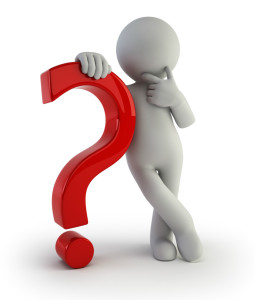How do you “call the question” in Robert’s Rules?
 The motion “to call the question,” which has the technical name of “previous question,” may be the most abused motion in all of Robert’s Rules of Order. It is very common for people to shout out the word “question” or “I call the question” in the expectation that debate will immediately stop, and a vote will be taken. This is WRONG, WRONG, WRONG.
The motion “to call the question,” which has the technical name of “previous question,” may be the most abused motion in all of Robert’s Rules of Order. It is very common for people to shout out the word “question” or “I call the question” in the expectation that debate will immediately stop, and a vote will be taken. This is WRONG, WRONG, WRONG.
Key points to know about “call the question”
- A member must have the floor in order to make this motion. Raise your hand and wait until the chair gives you the nod – “recognizes you” – before speaking.
- When you make this motion, you are only suggesting that YOU would like to stop debate and vote. It is an expression of your wish, not a hammer to bludgeon your colleagues.
- This motion requires a second. There have to be at least two people in the room who want to cut off debate before it can be considered.
- This motion cannot be discussed or debated. As soon as the chair hears a second, she immediately takes the vote.
- It takes TWO-THIRDS of the voting members in favor to cut off debate. Therefore the chair should take the vote by show of hands, and not by voice.
- If indeed two-thirds of the group want to stop debate and vote, then the chair immediately takes the vote on the pending motion – the motion that the group is considering at this time. No further discussion is allowed.
- It is also possible to call the question on ALL the pending motions, in which case the chair will take the vote on each motion that is before the group, one after another.
- Robert’s Rules of Order does not allow this motion to be made in committee meetings.
See our article No debate at all—legitimate, but unwise, for an example of the misuse of this motion.
Sample script for “call the question”
Member A: I call the question.
Member B (without being recognized): Second!
Chair: It has been moved and seconded that we stop debate and vote on the pending question, which is [state the motion being discussed].
All those in favor of stopping debate and voting now, raise your right hand. [Members raise hands.]
Thank you, hands down.
All those opposed, raise your right hand. [Members raise hands.]
Thank you, hands down.
[If the ayes have it:] There are two-thirds in favor and we will vote immediately. [Take vote]
[If the noes have It:] There are not two-thirds in favor and debate will continue. Next speaker please…
What does the motion “to call the question” or “previous question” really mean?
This motion is actually a “vote on whether to vote.” The term “previous question” is an unhappy leftover from the 19th century. The words meant something completely different in the British parliament. We believe that it would be better to rename this motion as “the motion to stop debate” or “motion to vote immediately.”



How soon should an emergency meeting take place once it is requested?
Bonny, there is no fixed rule about this. Looking forward to talking soon!
How do you show in the minutes that the Chair did not recognize the need for the 2/3 vote, and just allowed the vote on the question? Here’s how it went down in the meeting:
Member A: I call for the question.
Chair: “Lets go ahead and vote”
The Board voted on the motion that was on the floor.
No one challenged the vote, until the next day, a member sent our manager a seething email about parliamentary procedure.
So, what is the best way to show this in the minutes?
Julie, the chair was acting above his powers, but since no one questioned it at the time, it is too late to complain now. The proper thing to do would have been for the member to make a “point of order,” objecting to the chair’s high-handedness. But this motion may only be made during the time interval up until the next item of business is taken up. So the minutes will not reflect anything about this, they will simply note the vote that was taken. Minutes do not include minor procedural matters (see our recent blog posting “what to include in minutes”).
Thank you! I dont think the Chair was acting above his powers, I think he just didnt know that he was supposed to call for the 2/3 vote. In actuality, I dont think any of them did, until it was researched by the angry board member.
Thank you again!
In reading this, the last comment about call the question of all the motions, does that mean we should have all motions to be decided on, ahead of the meeting? I ask because often there are members of our council that will come to the meeting and propose motions without anyone on council having proper documentation to make decisions? We do have a policy which states that we must submit our agenda items with proper backup documentation but it is very loosely followed, How should I handle? If the item is allowed to be added to the agenda in the beginning of the meeting, it then would not fall under the rule of following the agenda? Your guidance is appreciated!
Jeannine, there are several aspects to this question.
1) First, state regulations or your own bylaws/guidelines may require advance notice for all matters to be decided. If that is the case, the requirement should be followed. If members bring a new matter up that violates those rules, the chair should explain and state that the item will be added to the next meeting’s agenda (or handled in whatever way is proper).
2) Private nonprofit bodies are different, and here, unless you have a policy in place, members may bring something new up at a meeting. However, many boards adopt a “no-surprises” rule and this can be sensible to have. There is greater likelihood, when deciding something “on the fly,” of making an ill-considered decision that will have to be changed later.
In general we recommend educating your members about these issues so that when a specific incident arises, there is a framework, and people don’t take it so personally.
Hope this helps!
How would you do this for an online email vote?
Cheryl, there is no general guidance on this. Your organization should adopt specific rules for online meetings and voting. Robert’s Rules of Order Newly Revised, 11th edition, the current version of Robert’s Rules, gives guidance about electronic meetings on pp. 97-99. The National Association of Parliamentarians also published Rules for Electronic Meetings: A guide to develop rules for E-Meetings in 2009, though I don’t see it in their list of current merchandise. You could write and ask them if it is still available.
If “calling the question” is moved very early in debate and is being used to suppress debate and discussion, can the chair declare the motion out of order?
Josh, the key point is that “call the question” requires approval of two-thirds of the members to pass. So even if it occurs very early on, and has the effect of suppressing debate and discussion, if two thirds are in favor, that’s what happens. The chair CANNOT declare the motion out of order.
I know of one city council that had a habit of calling the question almost immediately after the motion was stated, when debate had hardly begun. It seemed to me that the members were not fulfilling their duty to consider matters in depth. From a procedural point of view, however, it was all right for them to do this.
[…] some point, during any of our meetings, there would always be a moment when someone would “Call the question.” For years, that term alluded me. We are sitting here discussing a decision that needs to be made […]
I have a question (groan regarding calling the question. You say that a motion to call the question requires a second, but I cannot find that requirement in Robert’s Rules. This is very pertinent to something that came up last night in a local governing body’s meeting. I am not doubting your interpretation, but please point me to the section of Robert’s Rules that requires a second on a motion to call the question. Thanks.
Allen, are you working with the current edition: Robert’s Rules of Order Newly Revised, 11th edition? The technical name of this motion is the “Previous Question,” and on p. 199, RONR 11th edition says that the previous question “must be seconded.” Hope this helps!